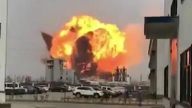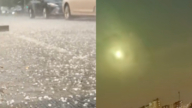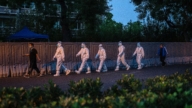【新唐人2013年12月27日訊】中國的霧霾現象越來越嚴重,擴及的省份也越來越多,老百姓是「霾」怨不斷。最近在北京舉行的第四次「財新峰會」上,學者指出,治理中國空氣污染的帳單將高達2900億美元。有評論認為,中共投入鉅款來治理空氣污染,有多少錢會用在治理空氣污染上?會不會到頭來還是「萬億散盡,污染依然」、「肥了官吏,苦了人民」。
大陸中央氣象臺25號6點繼續發佈「霾黃色預警」:預計25號白天,北京南部、河北中南部、天津、山西南部、山東中西部、河南北部、陝西關中、江蘇等地,空氣污染氣象條件5級,局地可達6級,不利於空氣中污染物擴散,上述大部地區有中度霾,部分地區有重度霾。25號夜間開始,上述地區的霾將自北向南逐漸消散。
河北省從21號起,已連續發佈「霾黃色預警」信號。此外,吉林、山東、江蘇等省市也紛紛發佈霾預警。在首批公布的74個城市中的PM2.5資料中,有16個城市的空氣質量為「嚴重污染」。空氣質量最差的10個城市中,河北省佔了6席。其中石家莊、邢臺、保定、邯鄲「爆表」﹗空氣污染指數超過500。
對於霧霾到底是天災還是人禍這個問題,中國的非政府環保組織最近舉行講座,針對聯合國下屬的「政府間氣候變化專門委員會(IPCC)」發佈的最新氣候變化報告,進行了討論。
與會的「中國人民大學」教授王克,談到中國的碳交易環境時表示:「我們國家現在沒有一個總的嚴格約束的目標。」
據了解,目前中國碳排放總量已經成為世界第一,而歐美則呈下降趨勢。
廣州財經、社會類評論家 鞏勝利:「肯定是人禍,如果是天災的話,歷史上就沒有發生過,因為中國五千年來沒有發生過,霧霾空氣當中含有害顆粒。所以我覺得特別是胡、溫時期,可能是致命的要害者,因為他們對發展只要速度是不講質量。」
中國南方地區從12月開始,也被霧霾襲擊,波及25個省、100多個城市。23號,大範圍的霧霾天氣明顯加重,除了河北石家莊、邯鄲的空氣達到嚴重污染級別,伸手不見五指外,在四川東部的廣安、達川等地城市鄉村,也籠罩在瀰漫的陰霾中。
而在西安霧霾有多嚴重?有網友在微博貼出西安著名地標「大雁塔」的對比圖,一張10月24號拍攝的照片,「大雁塔」穩穩立在圖片中央,塔背後的建築也清晰可見﹔而在12月18號拍攝的照片中,這座大約有1300年歷史的「大雁塔」不見了,只剩下了兩排樹木。網友戲稱,莫非,「大雁塔」被發射了?「全國人民熱烈慶祝大雁塔發射成功!」
另外,在交通方面,鄭州市交巡警支隊指出,電子眼需要同時拍攝到信號燈和車輛號牌,兩者缺一不可。如果霧霾嚴重到連人眼都不能識別信號燈,那麼電子眼肯定也識別不了。
在北京舉行的第四次「財新峰會」上,與會中國學者表示,治理中國空氣污染的帳單將高達2900億美元。
浙江杭州環保維權人士 陳法慶:「國家投入這麼大鉅額的資金來治理環境污染,當然受傷害的還是中國13億的老百姓,我們連呼吸的空氣都這麼污染了,你看那些媒體還說,我們的空氣比較好,沒有霧霾,主要是中央的高層對這個重視不夠,也就是說,是呼籲的多,做的少,主要的根源在這裡。」
對於世界任何城市而言,上千億美元的投資都是一筆天文數字,然而這筆龐大的投資是否真的有效果,可以讓中國的居民出門不再需要戴口罩?還是需要時間來證明﹗不過眼前的這筆鉅額,民眾恐怕是得先買單了。
採訪/朱智善 編輯/黃億美 後製/孫寧
Who will pay for the $290 billion smog treatment?
The smog has grown more and more severe and has spread,
causing a serious issue for the Chinese.
At the 4th Caixin Summit, experts reported that controlling
air pollution will cost $290 billion.
People question such a high figure.
They wonder whether the money will go towards improving
the air quality or simply line the officials’ pockets.
The Chinese National Meteorological Center (NMC) issued
a yellow – meaning mid to heavy – smog warning on Dec. 25
for the smog covering Beijing, Tianjin, and cities of Hebei,
Shanxi, Shandong, Henan, Shaanxi, Guanzhong and Jiangsu.
The smog will dissipate gradually from north to south
in the evening, the NMC informed.
Since Dec. 21, a yellow warning has been issued for Hebei.
In addition, Jilin, Shandong, and Jiangsu have also issued
haze warnings.
According to the PM2.5, the index that measures particle
matter, 16 out of 74 cities have heavily polluted air.
Among the 10 worst cities, six are located in Hebei,
and four – Shijiazhuang, Xingtai, Baoding, and Handan –
had PM2.5 measurements over 500.
Environmental NGO’s in China recently held talks
regarding whether smog is a natural disaster or is man-made.
They discussed the latest report from the UN
Intergovernmental Panel on Climate Change (IPCC).
Wang Ke, professor at Renmin University in China,
indicated that “China does not have an overall restriction goal"
regarding carbon reduction.
It is understood that China’s carbon footprint
is unprecedented.
Meanwhile, the Western world has taken steps
to reduce theirs.
Gong Shengli, commentator: “It is certainly man-made.
In the five thousand years of Chinese history,
there has never been smog.
There are toxic particles in the smog, surely it is man-made.
I believe that Hu and Wen are the main culprits, because
they developed the economy at the risk of the quality."
Since December, smog has affected Southern China,
covering 25 provinces and more than 100 cities.
On Dec. 23, a wide range of thick smog affected
Shijiazhuang and Handan of Hebei province,
and also shrouded the eastern portion of Sichuan.
The severity of smog in Xi’an is also revealed in netizens’
online photos.
Famous Xi’an landmark Giant Wild Goose Pagoda
was shown in two photos taken on Oct. 24 and Dec. 18.
In the Oct. 24 photo, the Pagoda firmly stands center
and the background is clear.
In the Dec. 18 photo, this 1,300 year-old historical building
had disappeared; only the tree lines were visible.
Netizens ridiculed, “Has the Pagoda been launched
(into flight)?"
“The whole nation celebrates the successful launch
of the Pagoda!"
In addition, according to Zhengzhou City Traffic Patrol,
traffic cameras need to detect both traffic lights
and vehicle license plates for traffic control purposes.
However, if the smog is so heavy that human eyes can’t see
the signals, the cameras won’t be able to detect signals either.
At the 4th Caixin Summit, participants indicated that it will
cost $290 billion to improve China’s air quality.
Chen Faqing, Hangzhou environmentalist: “With such
a large investment in environmental pollution, of course
the 1.3 billion Chinese will bear the cost.
The air we breath has been so polluted but the media still
claims the air is good and is without pollution.
The Central officials don’t care about this.
That’s the main issue – more talk than action."
Billions of dollars is an astronomical sum for any city
in the world to invest.
As for whether this investment will truly improve
the air quality, only time will tell.
It is such an enormous sum and the masses
of Chinese have to foot the bill.
Interview/ZhuZhishan Edit/HuangYimei Post-Production/SunNing





























